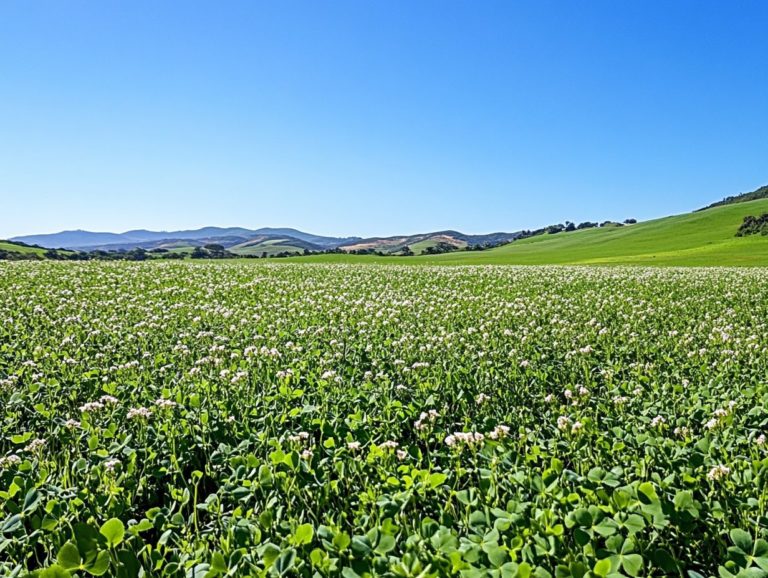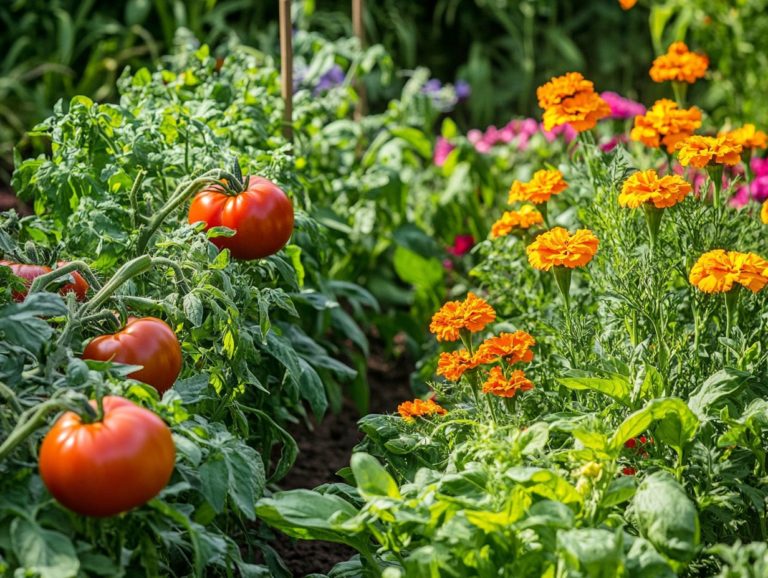“Understanding the Importance of Plant Diversity”
Join us as we explore the exciting world of plant diversity and how you can make a difference! Plant diversity is essential for maintaining healthy ecosystems and nurturing a vibrant planet.
By fostering biodiversity, plants provide crucial environmental and economic benefits, serving as the backbone of our natural world. However, human activities and climate change present significant threats to this diversity, endangering the delicate balance within ecosystems.
This article highlights the importance of plant diversity, the challenges it faces, and presents actionable steps for conservation. Discover how preserving plant diversity can pave the way for a more sustainable future.
Contents
- Key Takeaways:
- Why Plant Diversity Matters for Ecosystems
- Benefits of Plant Diversity
- Threats to Plant Diversity
- Ways to Promote Plant Diversity
- Frequently Asked Questions
- What is plant diversity and why is it important?
- How does plant diversity impact the environment?
- Why should we be concerned about the loss of plant diversity?
- How does plant diversity benefit human health?
- How can we promote plant diversity?
- What can happen if we continue to ignore the importance of plant diversity?
- Get Involved!
Key Takeaways:

- Plant diversity is essential for maintaining healthy ecosystems.
- It provides vital environmental and economic benefits.
- Human actions and climate change threaten plant diversity, but we can help protect it.
Why Plant Diversity Matters for Ecosystems
Plant diversity holds a pivotal role in sustaining healthy ecosystems. It enriches biodiversity, bolstering the resilience of ecological communities against pests, diseases, and environmental shifts.
The complex interrelationships among various plant species lay the groundwork for food webs and habitat structures. This ensures ecosystems operate effectively and sustainably. Preserving plant diversity is essential for maintaining vital ecosystem services, including soil stabilization, carbon absorption, and water purification.
Ultimately, this preservation benefits the environment and enhances human well-being.
The Backbone of Biodiversity: Plants
Plants serve as the backbone of biodiversity within ecosystems, offering habitat and resources for a diverse array of organisms, from the smallest insects to large mammals.
The intricate relationships among various plant species create essential environments that nurture a multitude of life forms. For example, forests provide shelter and nourishment, while grasslands offer open spaces for myriad wildlife to flourish. This interconnectedness sustains complex food webs, where every species has a unique role from primary producers to top predators.
These plant communities play a crucial part in maintaining ecological balance, regulating factors such as soil quality, water retention, and atmospheric conditions. By enriching the environment, they ensure the resilience and sustainability of ecosystems, fostering a vibrant tapestry of life capable of adapting and thriving amidst changing circumstances.
Benefits of Plant Diversity
The advantages of plant diversity go well beyond mere aesthetics; they encompass essential environmental and economic benefits that significantly enhance the health and sustainability of both ecosystems and human communities.
Environmental Benefits

One of the key environmental benefits of plant diversity lies in its remarkable ability to provide essential ecosystem services, such as climate regulation, soil fertility, and flood control which means how plants help absorb excess water during heavy rains.
This impressive variety of plant species plays a pivotal role in absorbing carbon dioxide, effectively mitigating climate change and stabilizing atmospheric conditions. With their unique root structures and growth patterns, different plants enhance soil quality by preventing erosion and promoting nutrient cycling crucial elements for successful agriculture.
A diverse plant community cultivates rich habitats for wildlife, allowing various species to thrive and preserving biodiversity. For instance, wetlands with native plants actively filter pollutants and serve as buffers against floods, functioning as natural barriers that protect surrounding ecosystems.
Act now to ensure future generations can enjoy these benefits!
Economic Benefits
Plant diversity offers significant economic benefits, influencing sectors such as agriculture, tourism, and medicine. It plays a vital role in local and global economies.
The variety of plant species you cultivate can enhance the ability of crops to withstand challenges, a crucial factor in tackling food security challenges. This diversity supports sustainable farming practices and attracts eco-tourists eager for unique experiences in biodiverse regions.
Tourism thrives on rich plant ecosystems, allowing individuals to trek through lush rainforests and explore botanical gardens.
The medicinal field reaps substantial rewards from plant diversity, as many pharmaceutical companies depend on a wide range of flora to develop life-saving treatments.
Exploring these diverse species can lead to groundbreaking discoveries, highlighting how interconnected these sectors are with the health of our natural environment.
Threats to Plant Diversity
Despite its crucial role, plant diversity encounters many threats, primarily stemming from human activities and the impacts of climate change. These factors threaten the health of our ecosystems globally, underscoring the urgent need for awareness and action.
Human Activities and Climate Change
Human activities, such as deforestation and pollution, alongside the escalating effects of climate change, present significant threats to plant diversity and the overall health of ecosystems.
These actions disrupt natural habitats, leading to the unfortunate loss of native plant types that are vital for maintaining ecological balance. For instance, clearing forests for agricultural expansion reduces the number of trees and impacts the understory plants that depend on the canopy for essential light and protection.
Pollutants can seep into soils and waterways, altering plant chemistry and making it increasingly difficult for certain species to thrive.
As temperatures rise and weather patterns grow more erratic due to climate change, the survival of vulnerable plant populations faces even greater challenges. We must act quickly to adopt sustainable practices to safeguard our planet’s rich biodiversity.
Ways to Promote Plant Diversity

Promoting plant diversity is essential for safeguarding ecosystems, and you can play a pivotal role in this endeavor. Engage in a combination of conservation efforts, take individual actions, and support educational initiatives to raise awareness about the critical importance of biodiversity.
Every little action you take can make a big difference for our planet!
Conservation Efforts
Conservation efforts are essential for protecting plant diversity. They involve strategies like rebuilding natural environments, preservation of natural areas, and the establishment of protected reserves.
These initiatives are crucial in addressing challenges posed by climate change, urban development, and invasive species. Organizations such as the World Wildlife Fund (WWF) and the Royal Botanic Gardens, Kew actively participate in projects aimed at safeguarding endangered plant species through seed banks and botanical gardens.
In the Hawaiian Islands, community-led restoration projects have revitalized native flora. By cultivating local partnerships, these organizations effectively enhance awareness and mobilize resources, ensuring that both rare and common plant species flourish in their natural habitats.
Individual Actions
You can play a pivotal role in promoting plant diversity through sustainable practices, community engagement, and support for protecting the environment.
Get involved in local conservation efforts, join gardening clubs, or volunteer with organizations dedicated to native plant restoration. Incorporating native species into your personal garden or community plots nurtures local flora and supports vital wildlife habitats.
Educate others about the significance of plant diversity and advocate for policies that safeguard natural habitats. Participate in initiatives like seed swaps or plant exchanges to foster connections within the community while nurturing biodiversity. Each step you take contributes meaningfully to the mission of sustaining environmental health.
Frequently Asked Questions
What is plant diversity and why is it important?

Plant diversity refers to the variety of plant species, both wild and cultivated, found in a particular area or ecosystem. It is crucial for maintaining a healthy and balanced ecosystem, providing benefits such as purifying air and water, regulating climate, and supplying food and resources for humans and other species.
How does plant diversity impact the environment?
Plant diversity plays a vital role in maintaining the health and stability of the environment. Different plant species have unique characteristics that contribute to the ecosystem, such as preventing soil erosion and regulating water flow. A diverse plant community combats climate change by absorbing carbon dioxide and producing oxygen through photosynthesis.
Why should we be concerned about the loss of plant diversity?
The loss of plant diversity can lead to severe consequences for the environment and human well-being. It can decrease food production, result in the loss of medicinal plants, and disrupt essential natural processes. This loss also reduces ecosystem resilience, making them more vulnerable to diseases and disasters.
How does plant diversity benefit human health?
Plants are a source of food and resources, and they possess medicinal properties utilized for centuries. A diverse range of plant species increases the chances of discovering new medicines and treatments for health conditions. Additionally, plant diversity promotes mental well-being by providing aesthetic and recreational value.
How can we promote plant diversity?
As creators, we must take initiatives that go beyond simple gardening. Individuals can promote plant diversity by planting various native plants in their gardens, supporting organic farming practices, and avoiding harmful pesticides and herbicides. Governments and organizations can implement policies to protect and restore natural habitats, conserve endangered plant species, and promote sustainable land use practices.
What can happen if we continue to ignore the importance of plant diversity?
Ignoring plant diversity now can lead to dire consequences for our planet. A continued disregard may result in further loss of plant species, declining ecosystem health, and severe repercussions for both the environment and human society, including food shortages and increased vulnerability to natural disasters and climate change.
Get Involved!
Start planting native species today to make a difference! By taking action, you can help preserve our planet’s plant diversity.






